
Interference Test According to Stroop - STROOP - 1 Year License
Model 64071
Registration of the color-word interference tendency, i.e. impairment of the reading speed or color recognition due to interfering information; applicable to adults.
Test Overview
This test provides a fair and highly reliable assessment of the ability to inhibit overlearned answers to simple tasks.
Main Areas of Application
- Clinical psychology
- Neuropsychology
Theoretical Background
The present form of the Stroop Interference Test is the computerized Color-Word interference paradigm by Stroop (1935). It is based on the assumption that reading speed of a color-word is slower, if the word is written in a differently colored font. There is always a delay in naming the color of this word, if color and color-word do not match. This paradigm results in two experimental conditions without interference influences:
- Determination of the reading speed of a color word alone
- Determination of the color naming speed.
This initial performance is used as "baseline" and can be related to the two so-called interference conditions, which are described below:
- Reading speed alone with the experimental set-up "color interference": reading speed of the color word decreases if the word is written in a different color
- The experimental set-up "word interference", where naming the color is made more difficult since color-word and color in which the color word is written do not match
Administration
The task is to press the correct respective entry field or color button as fast as possible.
Test Forms
Generally four test forms are available. Test forms S4, S7 and S10 determine first the "baseline" then the "Interference condition". The three test forms vary as regards the input medium and the instructions (the respondent names / does not name the color aloud). Test form S8 differentiates between so-called "congruent" items - color and meaning of the word match - and "incongruent" items - color and meaning of the word DO NOT match.
Scoring
The main variables are reading interference (the difference of the reaction time medians of the "reading interference condition" and the "reading baseline") and the naming interference (the difference of the reaction time medians of the "naming interference condition" and the "naming baseline"). Additionally, the following variables are issued for each individual test part: "Median reaction time" and the "Number of incorrect answers". The test protocol shows each single reaction of the respondent with reaction time of the respondent and evaluation of the reaction.
Reliability
The split-half reliabilities for the norm sample varied between r=.85 und r=.99.
Validity
The validity of the test STROOP-Tests is confirmed by numerous comparative examinations with clinical groups and healthy people (extreme group validation), as well as by examinations regarding its convergent and divergent validity. The computerized form was designed exactly according to the paradigm of the color-word interference by Stroop, taking into account further scientific developments (e.g. Bäumler, 1985). It proved that patients with cerebral lesions require much more time to do tasks under interference conditions, and that the test STROOP differentiates reliably between patients and healthy people (c.f. Perret, 1974; in Wittling, 1983; Beaumont, 1987).
Norms
A comparative sample of N=254 normal people is available for form S4. A standardization to normal persons (representatively) is available in each case for forms S7 (N=343) and S8 (N=327). They consist of data from the Schuhfried Company's research laboratory.
Testing Time
About 15 minutes.
VTS System Overview
The Schuhfried VTS enables computer-assisted application of a large number of highly diverse psycho-diagnostic tests and measuring procedures. In developing the system much emphasis was placed on transparent structure and largely uniform design. It is therefore simple to operate and easy to understand and does not require any special computer skills.
The VTS basic module is required for administration of any of the available tests.
The Schuhfried VTS supports the administration of both single tests and test batteries. Many of the single tests are available in different test versions. These test versions may differ, for example, in terms of test duration or difficulty or may be parallel forms. They are characterized by different parameters reflecting specific test requirements. They have been designed for administration to a specific population (e.g. psychiatric patients, children, etc.) or for special measuring purposes (e.g. repeated measurements). Test batteries are compiled from the available single tests and test versions.


